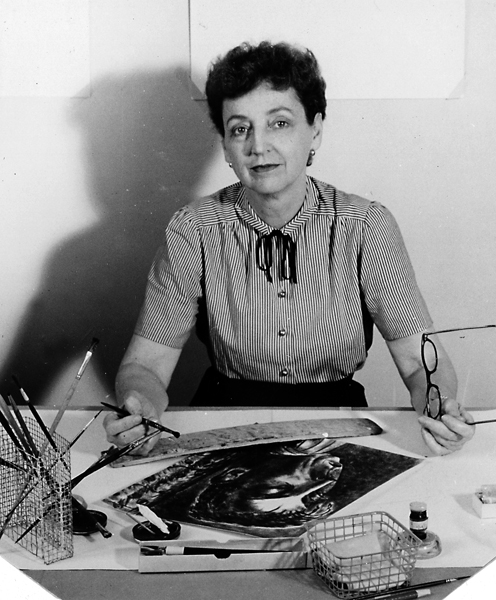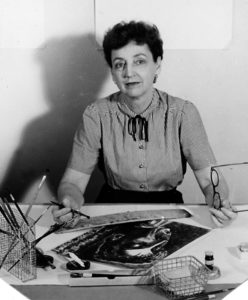Federal Art Project
The Federal Art Project was a Depression-era effort to bring art and artists into the everyday lives of Americans while simultaneously extending work relief to artists.

Courtesy of State Library of Louisiana
Caroline Durieux. Unidentified
Established by the Works Progress Administration in 1935, the Federal Art Project (FAP) was an effort to bring art and artists into the everyday lives of Americans while simultaneously extending work relief to artists. Of the four separate New Deal attempts to patronize the visual arts, the FAP was the largest, most ambitious, and most controversial by far. Curator, art critic, and historian Holger Cahill, who served as director of the project, oversaw the individual state branches, including the Federal Art Project in Louisiana (LAP). Between 1935 and 1943, when the program ended, the LAP employed more than fifty artists, primarily in New Orleans. Their collective efforts produced hundreds of original art works allocated among dozens of public institutions throughout Louisiana and across America.
The Federal Art Project
One of five cultural programs collectively known as Federal One, the Federal Art Project complemented the efforts of the Federal Writers Project, the Federal Theater Project, the Federal Music Project, and the Historical Records Survey. All five agencies administered offices in each of the (then) forty-eight states, meeting with varying degrees of success. At the national level, Federal One projects were overseen and administered by the Works Progress Administration (WPA), later renamed the Works Projects Administration.
In many ways, the goals and policies of the FAP reflected the aesthetic values of Holger Cahill, its director. Interested in blurring the boundary between so-called high and low—fine and folk—art, Cahill wanted to revolutionize the way Americans created, consumed, and understood art. To do this, he developed several different FAP programs. First, Cahill worked to establish community art centers across the country. At these centers, artist-workers, laboring on a wage scale, created art that was either allocated to public buildings or displayed in the center’s exhibition gallery. Much of this art was produced in bulk. Adjoining classroom facilities offered free instruction in art creation and appreciation. For those unable to attend classes, provisions were also made to send FAP artists out into the community.
In an affiliated project, the FAP hired artists in various media to record local vernacular craftsmanship, much of it on the brink of ruin. The result was The Index of American Design, a collection of more than 18,000 images illustrating traditional American arts and crafts. Third, in both 1940 and 1941, FAP units across the country participated in National Art Week, a nationwide set of exhibitions and sales campaigns timed for the onset of the Christmas shopping season.
In short, between 1935 and 1943, the FAP worked to make art a mass experience, and none of this occurred without provoking substantial criticism and controversy. Conservative art academicians resented Cahill’s abandonment of a high art canon and deplored his determination to democratize art. Critics on the Left, though generally more supportive, chafed at the FAP’s resistance to more experimental, less representational forms. Meanwhile, the FAP’s challenge to entrenched local traditions ruffled feathers in communities all across the country, including New Orleans.
The Louisiana Art Project
Ultimately, Holger Cahill appointed three different directors of the LAP, the state FAP affiliate established in New Orleans. Though Cahill later regretted his decision, Gideon Stanton, the first director of the LAP, seemed like the perfect choice. Born in Minnesota, Stanton moved to New Orleans as a boy. He studied art in New York and Baltimore before returning to New Orleans to join a brokerage firm, where he prospered. But in midcareer, Stanton quit the market to pursue his art, painting most often in oils but in other media, too. With his friend and colleague Ellsworth Woodward, a professor of art at Newcomb College and a pillar of the New Orleans art establishment, Stanton played a vital role in the artistic community. In 1912, he joined the Artists’ Association of New Orleans, serving as board member, secretary, and eventually president. In 1927, he cofounded the New Orleans Art League and was also affiliated with the Arts and Crafts Club, the Southern States Art League, and the Isaac Delgado Museum of Art (now the New Orleans Museum of Art).
Stanton’s appointment initiated what became a continuous and revealing three-year confrontation with his national project supervisors. They quarreled over virtually every aspect of the project, large and small. They argued about minutiae including time sheets, vacation days, assigned work quotas, and the like; they quarreled about important issues such as the purpose of federal art sponsorship. By assuming the power to patronize art, regulate production, and stimulate consumption, the FAP proposed to modernize American art. In the process, it hoped to create a national arts community by absorbing or bypassing the very kinds of local arts institutions Stanton had worked to build.
Because the power to define art and artist represented the power to define society, the FAP represented a direct challenge to local social elites, as Stanton clearly grasped. In traditional thinking aligned with Woodward, Stanton interpreted an artist’s economic need as evidence of insufficient skill, arguing that such artists should not be patronized, especially by Depression-wracked taxpayers. Relaxing aesthetic standards in the interest of financial relief, he warned, could only result in the creation of inferior art. Stanton professed values diametrically opposed to Holger Cahill’s more egalitarian vision of art and society. Because they had been artificially constructed, largely to defend the status of recently established industrial elites, Cahill sought to demolish the very standards Stanton struggled to defend.
Essentially, the conflict concerned which artists Stanton could or should hire and how best to utilize their talents. Stanton continued to guard against modern aesthetics and their populist implications, which ultimately provoked open confrontations with several of his personnel. Meanwhile, national administrators chafed at the stalemate and, toward the close of 1938, provoked one last row that ended with Stanton’s resignation.
From 1939 until its demise in 1943, two women, both artists and former students of Ellsworth Woodward, directed the LAP. Lithographer Caroline Durieux succeeded Stanton in February 1939. An enthusiastic supporter of the federal art initiative, Durieux immediately set about expanding the project’s presence within New Orleans and across Louisiana. From classes for children and adults in Baton Rouge to exhibitions in Reserve, Covington, and Boothville, to individual decorations for City Park, the Audubon Zoo, and the Magnolia Housing Project, it seemed that the FAP had finally arrived in Louisiana. Yet none of Durieux’s numerous initiatives pleased the Washington administrators more than her formal proposal to establish the Orleans Parish Art Center. Featuring two exhibition galleries—one for local displays and another for national FAP tours—classroom facilities, and production space for local project artists, the center was intended to be an important cultural resource, but the effort went for naught. Durieux’s plans for expansion coincided precisely with the demise of Federal One. In the spring of 1939, Congress abolished the Federal Theater Project and eliminated the national administrative structure of the remaining WPA cultural projects. The affiliated projects, the LAP among them, were returned to the states and forced to secure local sponsorship. For all practical purposes, the WPA reorganization limited the LAP’s efforts to the French Quarter, specifically to its local headquarters on Royal Street.
In June 1941, sculptor Angela Gregory became the final LAP director when Caroline Durieux left New Orleans to accompany an exhibition of democratic art through Latin America. Like her predecessor, Gregory was born and raised in New Orleans. She, too, was committed to the federal art idea, but by then the project in New Orleans had been reduced to the production of defense-related posters.
Some of the LAP art still exists, and all of it remains deeply related to one of the more momentous periods in the American experience. At one time or another, and in various combinations, several noteworthy Louisiana artists worked for LAP, among them Edward Schoenberger, Clarence Millet, Alice Fowler, Charles Reinike, Herbert Frere, Knute Heldner, Jane Ninas, Hans Manglesdorf, Amelia Geiger, and Lawrence A. Jones. Their work can be seen in collections in such places as the National Archives, the Louisiana State Archives, and Louisiana State University.
